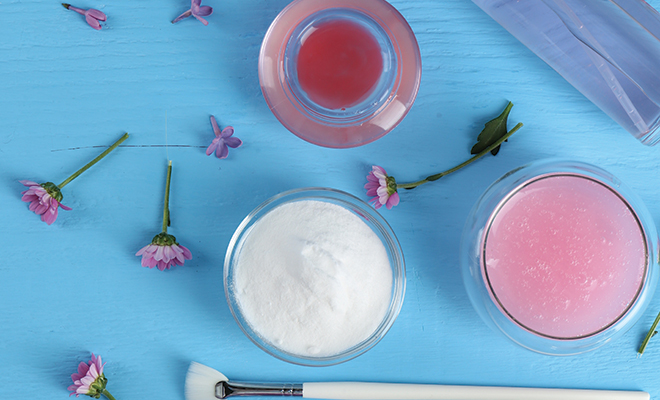
Clean Beauty: New Year, New Look
What exactly is clean beauty? Simply described, clean beauty means non-toxic. It’s a trend to make cosmetics safer for everyone by eliminating harmful chemicals and other ingredients from cosmetics and personal products.
The term is not government regulated, which leaves individual companies and groups to formulate their own definitions. In other words, what may be anathema to one group may pass another’s muster.
Some clean beauty companies have tied their clean beauty advocacy to other issues. Many of these companies also advocate for products that do not harm the environment, are ethically sourced, of non-animal origin, cruelty free, biodegradable, and do not contain residual pesticides.
In the European Union, there are over 1,300 chemicals banned from cosmetic and personal products. In the United States, the count’s only 11! Cosmetic companies are not required to reveal ingredients that may be considered trade secrets on their labels. Thus, suspicious ingredients can be hidden under an umbrella term such as fragrance, perfume or flavor. This way, no one knows if a potentially harmful ingredient is in the product or not. For this reason, it’s especially important that perfume be totally transparent in clean beauty circles.
What to Avoid
According to the company La Fervance, the following 12 chemicals used extensively in the cosmetic industry are so toxic that they could possibly cause cancers, damage organs or disrupt hormonal balance. They, and other clean beauty proponents, believe these ingredients, nicknamed the Dirty Dozen, should be eliminated from beauty and personal care products because of their toxicity.
BHA and BHT are antioxidants used as preservatives in cosmetics and food. They are carcinogenic, a possible hormone disrupter and cause liver and kidney damage.
Coal Tar Dyes appear as p-phenylenediamine and colors despite being known carcinogens.
DEA, MEA and TEA are substances used to make cosmetics creamy or sudsy. They are found mainly in moisturizers and sunscreens and have been linked to cancer.
Phthalates are found in fragrances, hair products, nail polish, lotions, soaps, detergents and food packaging. They may cause birth defects and disrupt the endocrine system.
Formaldehyde-Releasing Preservatives diazolidinyl urea, polyoxymethylene urea, sodium hydroxymethylglycinate, bromopol and glyoxal are known carcinogenic chemicals. They can cause adverse skin reactions.
Parabens are preservatives used in food, cosmetics and pharmaceutical products to prevent bacterial growth. They are linked to cancer and skin damage.
Perfume or fragrance can disguise up to 3,000 chemicals under this term. The disguised chemicals are often those believed to cause cancer or neurotoxicity.
PEG compounds contain carcinogens. They are found in creams, hair products and deodorants.
Petrolatum may be contaminated with other substances that are associated with cancer. Look for them in hair care products as well as cosmetic and skincare products.
Siloxanes are used to make cosmetics smoother, softer and creamier. Unfortunately, they are known endocrine disrupters and possibly cause fertility issues.
Sodium Laureth Sulfate is a foaming agent that can cause irritation. When it reacts with other chemicals, it may be carcinogenic.
Triclosan is a hormone disrupter that possibly causes liver damage. This antibacterial and antifungal agent is found in toothpaste, soaps, detergents, toys and deodorants.
According to clean beauty proponents, you will improve your health by avoiding the Dirty Dozen. One of the main ways to do this is by using clean beauty products that are screened for these chemical agents and substitutions made.
Where Can I Get Clean Beauty Products?
More cosmetic companies are experimenting with the trend toward clean beauty products, but the older companies have a definite edge. Look for the widest range of products from the following companies.
One of the leading clean beauty cosmetic firms is goop, started by Gwyneth Paltrow in 2008. The company now has a wide range of beauty products, clothing and wellness products in addition to other ongoing projects.
Another leading proponent of clean beauty products is Clean Beauty Collective, which lists its no-to ingredients on its website. They sell perfumes and other products through various major outlets and online.
Sephora and Ulta are well-known cosmetic outlets that carry many different brands of clean beauty products. Credo is an outlet dedicated to only clean beauty products. It is located mainly in California, Colorado, Texas, Massachusetts, Illinois, New York and online.
As with so many products, you will need to do your own research to find exactly what you are looking for. Not all chemicals are bad, natural is not always the best choice, but clean beauty is a trend worth exploring to get the best and safest beauty and personal products on the market. Once again, technology comes to our aid. Several apps can check the product you are interested in for information such as ingredients, safety and toxicity information, risk level and similar or alternative products. Eleven skin care ingredient checker apps are listed on healthline.com for your convenience.
Sources: safecosmetics.org, cleanbeauty.com, goop.com, nytimes.com, vogue.com and harpersbazaar.com.







